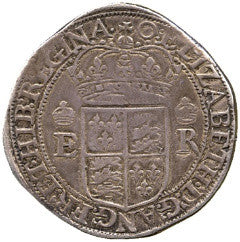In the late 16th Century the Spanish silver Eight Reales and its fractions were the most widely spread and populous Trade Coinage in the World.
The newly formed East India Company needed Spanish money to trade in the East Indies, however coins were in too short a supply and the Queen was petitioned to sanction minting of Spanish type Currency in London.
The Queen refuses to have foreign coin minted in the UK
Queen Elizabeth I (1558-1603) refused to sanction the coining of foreign type money in her own Mint, especially when negotiation over international trade circa 1599-1600 was so fragile with Spain.
Once negotiations broke down completely by July 1600 a British Trade Coinage for use in the East Indies that would compete directly with the Spanish Currency became more of a reality.
A Warrant for a New Trade Coinage and Minting
By the end of the year a warrant had been written for the coining of £5,000 worth of a new "Testern" trade coinage (as opposed to the Spanish Dollar) and four denominations were produced, the Eight, Four, Two and One Testern.
Eventually £6,066 worth of silver was coined by hand and a mere £25 worth was retained by the Company Secretary Richard Wright to distribute as "pieces of pleasure" to the Directors of the East India Company, as well as Lords and other very important persons connected with the company.
The other £6,041 was exported for trade in the East Indies on board the ship The Red Dragon under Commander Lancaster on 11th February 1601, reaching Sumatra on the 5th June 1602.
Majority for the Melting Pot
The coinage was used and spent, but the peoples of the East Indies did not recognise the strange designs and legends, and most if not all found their way quickly to the melting pot for the pure silver content.
Further voyages to the East Indies in 1604 and 1605 were subsequently loaded with the more familiar Spanish Dollars for trade.
 |
The Rare Survivors
Most of the surviving specimens today of these rare Trade coins are probably ones from the £25 worth held back in this country and approximately 50 specimens of each denomination are known.
The Eight Testerns is the largest denomination and there are only 47 specimens known today of which fourteen are housed in Institutions.
It is interesting to speculate that had the coinage been a success and dominated the Spanish currency, perhaps the US Dollar could have been the US Testern, as the USA took their currency denominations from the dominant Spanish coinage.
Description
Elizabeth I (1558-1603), Portcullis Trade Coinage of 1600, hand hammered silver Eight Testerns, mint mark 0 both sides (for year 1600), crowned quartered shield of arms of England and France, crowned E to left, crowned R to right, beaded circle surrounding, abbreviated Latin legend elizabeth d g ang fr et hib reg (Elizabeth by the Grace of God, Queen of England, France and Ireland, reverse, crowned portcullis with chains, beaded circle surrounding, abbreviated Latin legend posvi devm adivtorem mevm (I have made God my Helper, comp, Psalm 54), diameter approx 41mm, weight 26.47gms, Series of digs on portcullis, flan a little uneven, toned very fine for this rare issue and very rare.
For Sale: £16,000 Sorry, this item has already been sold, to get first refusal on new stock items please sign up to your free newsletter at the top of the page
(PT6)
For further information please email adrianroose@paulfrasercollectibles.com or telephone +44 (0) 117 933 9503






